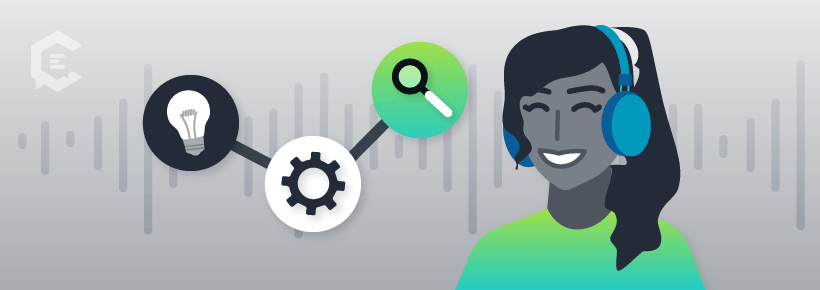Podcast listeners are loyal, affluent, and educated — and regardless if you’re a B2B or a B2C organization, these are the kinds of customers you most likely want to reach. More than 1/3 of Americans listen to at least one podcast per month — with 1 in 5 people listening to a podcast weekly.
Likewise, podcast listeners are 32 percent more likely than non-podcast listeners to make $75,000+ per year. Suffice it to say, there is a huge — and growing — opportunity out there for organizations who know how to develop podcasts.
The only problem is that podcasting is new enough that it probably isn’t something most people studied in school. Similarly, you may not have had much — if any — experience working with people who have developed podcasts for organizations.
So, the problem to solve is clear — but so is the opportunity. Our goal today is to get you on the right track to successfully develop your very own podcast. Yes, there will be some trial and error, but with this article as your guide, you’ll be able to get started with your podcast sooner than you think.
How to create a podcast in 11 steps:
Step 1: Define your audience and objective.
There is no reason to develop a podcast if you don’t actually understand for whom you are developing the podcast — and what you hope they do after having listened to it. Your goal may be to educate, to influence, or to pitch an idea.
Document your objective and your audience and don’t veer from these. This will be the backbone of everything else you do in the development and publishing of your podcast.
Step 2: Sweat the details.
Many of the marketing and SEO principles you have utilized throughout your career will be valuable as you document the title of your podcast (40 characters or fewer), develop a one-line podcast subtitle, and write a 1-2 paragraph podcast description.
Keep in mind a handful of keywords related to your audience and objective that should be utilized in the podcast title, subtitle, and description. Find a graphic artist to create podcast artwork for you.
Step 3: Purchase your equipment.
It’s true that you can use your computer’s internal microphone to record — but the quality of the podcast will certainly suffer. If you have a budget for your podcast (and please say you have a budget for your podcast), invest in a microphone, a microphone stand, a shock mount, and a windscreen that reduces the amount of popping heard from P and B sounds when you record.
Step 4: Create a show structure.
Ponder the topics related to your objective and audience. Draft a list of 10 topics that you could center an episode around. Consider how you will begin your podcast? What is the first thing your listeners will hear?
Obtain some royalty-free music or voiceover work that you can use to begin each podcast. Determine roughly how long your podcasts should be. A five-minute podcast might be more effective than a 60-minute podcast, depending on your audience and objective.
Step 5: Record the show.
Unless you have done a lot of recording, choose a software program to record with that is easy to use. A couple of nice solutions include Audacity and GarageBand — both of which are free to use.
Develop an outline for the show and the messages you will share. You may choose to script small segments of the podcast — but don’t script the whole thing. Keep it natural. Minimize distractions in the room so you can focus on the topic at hand. If you don’t have a recording studio, find a place where echoes are minimized.
Step 6: Edit your show.
When you edit the show, listen to the content how most of your audience would listen to it — through headphones. Focus first on editing the basic portion of the show — particularly your voice and the voices of anyone you interview. Once you are confident in this element, focus on your intro, outro, transitions, and other musical elements in the show.
Step 7: Upload your show to your media host.
First, set up your media host. Buzzsprout , ZenCast, Podbean, and Captivate are all potential options. Fill in the metadata and other information you compiled in Step 2. Remember to upload your podcast artwork.
Step 8: Validate your feeds.
It is important to validate your feeds in iTunes. This includes validating your feed at Cast Feed Validator, signing into Podcasts Connect with your Apple ID, and validating your feed in Podcasts Connect. Remember to also add the podcast to your website. For best results, develop and upload a handful of podcasts before you start to build awareness around them.
Step 9: Create an awareness plan.
If everything else about the podcast creation process has felt unfamiliar, this is the one area that should make you feel most at home — marketing your podcast. A number of ways in which you can create awareness of your podcast exist, including…
- Sending a devoted email to your email list
- Drafting a special blog post
- Teasing the episodes on social media
- Mobilizing micro-influencers to share thoughts about the new podcast
- Cross-promoting the podcast with companies and individuals interviewed or mentioned in podcast episodes
Just remember: If a podcast launches in a forest of podcasts and nobody is there to hear it, it doesn’t make a sound.
Step 10: Launch.
The week that you launch your podcast, make sure it has been submitted to iTunes Podcast Connect. Also make sure the podcast feed has been uploaded to Stitcher and Google Play. Execute your well-laid-out plans that you identified in your awareness plan and follow-up with those who committed to help raise awareness.
Weeks or months of preparation and work have led to this moment, so don’t let up. Make sure your launch plan is fully implemented.
Step 11: Repeat.
You probably won’t gain thousands of subscribers to your podcast overnight. In fact, you may not even gain dozens. If your podcast doesn’t bear immediate fruit, don’t give up. Follow the steps outlined above and continually improve them.
Make sure you give your podcast time to mature and make sure you give yourself time to figure out the nuances of the podcasting world. Yes, sooner or later you will need to determine if your podcast brings the ROI you seek, but don’t rush. Be patient. Keep learning and you increase the likelihood of being a successful podcaster.
Go more in-depth on how to start a podcast with this articles series:
- How Podcasts Became a Bit of an Addiction (and Led Me to Create My Own!)
- Hopping on the Podcast Caravan With One Foot Still Dangling Off
- Why It’s Important to Define Your Audience When Making a Podcast
- Scaffolding a Podcast Structure: Narrative or Conversational? Fiction or Nonfiction?
- Why Content Creators Turn to Podcasts As a Form of Expression






